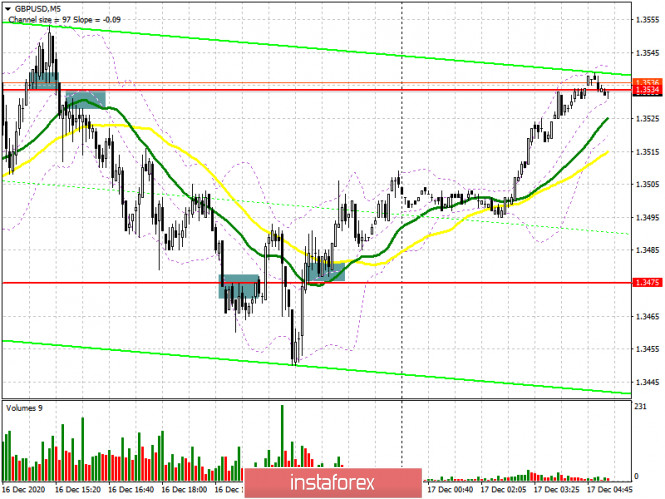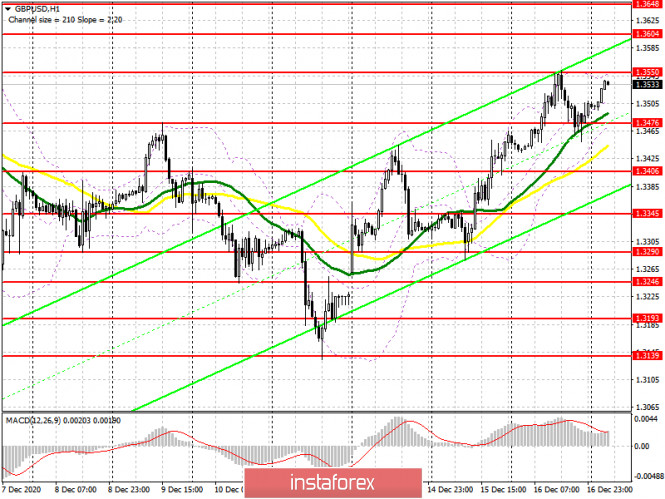
To open long positions on GBP/USD, you need:
Before talking about today's Bank of England meeting, let's see what transactions we had in the afternoon. I have marked four points on the 5-minute chart for entering the market. After a second return and a test of resistance at 1.3534, a signal to open long positions appeared, but, unfortunately, it was not realized, afterwards the pair moved below this area again. When the 1.3534 level was being tested from the bottom up, it was possible and necessary to sell the pound. This signal led to a large sell-off in the 1.3475 area. Towards the middle of the US session, the bears tried to take this level for themselves and even settled below it, which resulted in producing a new entry point for short positions, the movement down was around 25 points. After GBP/USD returned to the 1.3475 level after the Federal Reserve announced its decision on interest rates, this area was tested from top to bottom, which became a signal to open long positions. Now we have returned to the resistance area of 1.3534 and everything needs to start over.

The main task in the first half of the day is to surpass and settle above the resistance of 1.3550. A downward test of this level produces a good signal to open new long positions in sustaining the pound's growth, which will allow the pair to go beyond the wide horizontal channel, which is where it has stayed since the beginning of December. The nearest target will be resistance at 1.3604, surpassing it will quickly push the pair to the 1.3648 and 1.3698 areas, where I recommend taking profits. However, before buying the pound, you need to remember that the Bank of England will announce its decision on interest rates. Many expect the monetary policy to remain unchanged. Any unexpected statements in this regard could result in the pound's decline. Therefore, if GBP/USD is under pressure after the meeting, I recommend taking a closer look at long deals from the 1.3476 level, subject to forming a false breakout there. It is possible to buy GBP/USD immediately on a rebound from the low of 1.3406, counting on a correction of 20-30 points within the day. There are also moving averages, which play on the side of buyers. You should also pay attention to the bearish divergence, which has formed on the MACD indicator. If it persists after yesterday's high has been updated, and the pound does not actively rise above this level, it is better to leave long positions, since all this can lead to producing a false buy signal.
To open short positions on GBP/USD, you need:
Based on what we are seeing in the market right now, only bad news on the Brexit trade agreement can significantly pull down GBP/USD. The pound can not crash as long as the bull market is underway in all its glory and investors firmly believe that the negotiators will be able to find a compromise. Sellers currently need to form a false breakout in the resistance area of 1.3550, since this area leaves the last hope for the pound's fall in the short term. But if the pound does not actively fall after this, then it is better not to go against the trend, but to wait for the BoE's decision on interest rates and the renewal of resistance at 1.3604, from where you can sell the pound immediately on a rebound, counting on a correction of 20-30 points within the day. Larger resistance levels are seen around 1.3648 and 1.3698. An equally important task for the bears in the first half of the day will be to regain control over the 1.3476 level, which will seriously affect the positions of pound buyers. Getting the pair to settle in this area and testing it from the bottom up produces a good sell signal, the main goal is for the pair to fall towards 1.3406 and 1.3345, where I recommend taking profits.

The Commitment of Traders (COT) reports for December 8 notes significant interest in the British pound. Long non-commercial positions rose from 37,087 to 39,344. At the same time, short non-commercial positions decreased from 44,986 to 33,634. As a result, the non-commercial net position became positive and jumped to 5,710 against a negative value of -7,899 a week earlier. All this suggests that traders are ready to bet on the pound's succeeding growth at the beginning of 2021 and on the buyers' advantage in the current situation even when there is no trade deal at the moment, and take note that there is just around two weeks left until the end of the year.
Indicator signals:
Moving averages
Trading is carried out above 30 and 50 moving averages, which indicates the continued recovery of the pound in the short term.
Note: The period and prices of moving averages are considered by the author on the H1 chart and differs from the general definition of the classic daily moving averages on the D1 daily chart.
Bollinger Bands
A breakout of the upper border of the indicator in the 1.3550 area will lead to a new wave of growth for the pound. A break of the lower border of the indicator in the 1.3476 area will increase the pressure on the pound.
Description of indicators
Moving average (moving average, determines the current trend by smoothing out volatility and noise). Period 50. It is marked in yellow on the chart.Moving average (moving average, determines the current trend by smoothing out volatility and noise). Period 30. It is marked in green on the chart.MACD indicator (Moving Average Convergence/Divergence — convergence/divergence of moving averages) Quick EMA period 12. Slow EMA period to 26. SMA period 9Bollinger Bands (Bollinger Bands). Period 20Non-commercial speculative traders, such as individual traders, hedge funds, and large institutions that use the futures market for speculative purposes and meet certain requirements.Long non-commercial positions represent the total long open position of non-commercial traders.Short non-commercial positions represent the total short open position of non-commercial traders.Total non-commercial net position is the difference between short and long positions of non-commercial traders.